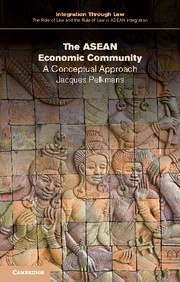Book contents
- Frontmatter
- Contents
- List of figures
- List of tables
- List of boxes
- General editors’ preface
- 1 Introduction and purpose
- 2 Foundations of economic integration fundamentals, stages and credibility
- 3 Conceptual foundation of the ASEAN Economic Community
- 4 Implementation of the AEC: progress in adopting instruments from the Roadmap
- 5 A reality check: comparing the AEC and NAFTA on substance
- 6 Options for the AEC and their practical implications
- 7 Conclusions
- Executive summary
- Appendix 1
- References
- Index
5 - A reality check: comparing the AEC and NAFTA on substance
Published online by Cambridge University Press: 05 March 2016
- Frontmatter
- Contents
- List of figures
- List of tables
- List of boxes
- General editors’ preface
- 1 Introduction and purpose
- 2 Foundations of economic integration fundamentals, stages and credibility
- 3 Conceptual foundation of the ASEAN Economic Community
- 4 Implementation of the AEC: progress in adopting instruments from the Roadmap
- 5 A reality check: comparing the AEC and NAFTA on substance
- 6 Options for the AEC and their practical implications
- 7 Conclusions
- Executive summary
- Appendix 1
- References
- Index
Summary
After comparing the AEC and NAFTA with respect to design (in section 2.4), the elaborate analysis of the expected and realised substance of the AEC until mid-2013 in this chapter provides a basis for a comparison with NAFTA on the substance of implementation. The AEC and NAFTA share several characteristics when it comes to substance, although this is rarely emphasised. Put differently, the substance of NAFTA does not seem overly ambitious for ASEAN when assessed against the backdrop of the emerging AEC. The most important difference is, of course, that NAFTA does not pretend to form a single market. However, if one studies the substantive building blocks, the two regional integration attempts are fairly similar. In order to clarify this point, Table 5.1 sums up the substance of NAFTA in the first two columns, with some comments in the third. The fourth column indicates whether the AEC has, or may have, similar provisions, and the fifth column stylises the EU regime in the same domain merely for comparison.
Table 5.1 summarises practically all the substantive provisions of NAFTA in fifteen horizontal or vertical domains (and the two side agreements on labour and environment). It is recommended that NAFTA should be evaluated against the backdrop of the Uruguay Round and the resulting Marrakesh Agreements of GATT/WTO, which six ASEAN countries have signed. NAFTA was negotiated before Marrakesh (1994), but the drafting of NAFTA's substance was simultaneous with the deliberations in Geneva on draft texts in, say, 1991–1993. NAFTA was also greatly influenced by the FTA between Canada and the United States concluded in 1989. Seen in this light, NAFTA is not a sensationally ‘deep’ FTA. As one can quickly derive from Table 5.1, NAFTA is a kind of ‘regionalised WTO-plus’.
This regionalised WTO-plus is characterised by both deepening of WTO commitments and some widening (beyond the scope of WTO disciplines). Deepening is found in tariff removal of the FTA in agriculture (where GATT/WTO does not yet go very far); in selective harmonisation (modest, now that the SPS agreement works); and in services (where GATS has similar principles, but with more remaining discretion for national governments and open-ended – in actual practice, disappointing – lists of commitments to open up; whereas in NAFTA the specifics are technical, yet, on the whole as well as in the sectors specified, they go further and are pre-committed, hence, give legal certainty for competitive strategies).
- Type
- Chapter
- Information
- The ASEAN Economic CommunityA Conceptual Approach, pp. 167 - 180Publisher: Cambridge University PressPrint publication year: 2016



